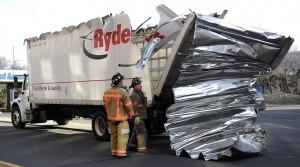Three ways an ounce of prevention can help you save big
Whether you have a private or dedicated fleet, preventing accidents from happening in the first place can go a long way toward protecting your bottom line – and keeping your vehicles, drivers and cargo on the road, serving customers and making money.
If you routinely transport goods and materials from one location to another, then you know that safety issues can derail even the highest-performing transportation network. Just last year, large commercial vehicles were involved in some 500,000 crashes.
It goes without saying that the human impact of truck-related accidents can be deadly. Crashes also have an impact on a business’s bottom line. For example, just offsetting the cost of a $25,000 crash (including cargo and vehicle damage, medical and injury costs) requires an extra $1.25 million in revenues. And that doesn’t include cost factors like damaged goods, missed customer commitments, vehicle downtime and replacement or administrative costs.

Given the potentially devastating impact of crashes and safety violations, what can you do to keep crashes from derailing your business? Of course, the best way is to keep them from happening in the first place. And while some incidents are unavoidable, improving driver safety is one way to put the brakes on accidents and safety-related violations.
When it comes to drivers, the three most common causes of crashes are unsafe driving, fatigue and health issues. Fortunately, you can take steps to mitigate these factors. Consider these three tips for improving driver safety and making safety a destination on your business roadmap.
-
Put the brakes on unsafe driving: Want to reduce crashes, fatalities and insurance claims? Safety starts behind the wheel. Use onboard technology to track unsafe behaviors like hard braking and speeding. By transforming ordinary trucks into connected trucks, you can identify good drivers, risky drivers and opportunities for training and improvement.
Telematics combines on-board computers, wireless communications and GPS to provide a birds-eye view of vehicles and drivers when they’re on the road. Telematics also monitors fuel consumption, idle time, truck location and other vital statistics and provides feedback to drivers on how safely they’re driving – all actionable information you can use to identify potential problems and improve safety.
-
Say good night to fatigued driving: Driver fatigue is a leading contributor to large-truck crashes. It impairs response time to hazards and increases the chances of being involved in a crash.
Fully 37 percent of drivers surveyed by the National Highway Traffic Safety Administration admitted to falling asleep at the wheel. The FMCSA recommends that drivers get enough sleep every night, maintain a healthy diet, take naps when they feel drowsy, avoid medications that induce drowsiness, recognize the signs of drowsiness and avoid alertness tricks to stay awake. In addition, encourage your drivers to get avoid driving between 12 AM and 6 AM.
-
Get drivers on the road to better health: Drivers work long hours, are sedentary for long periods of time and have irregular sleep patterns – and are categorically one of the unhealthiest populations in the country.
In fact, National Institute of Health statistics show that more than half of all truck drivers are obese and 87% have hypertension. Poor driver health goes hand in hand with driver fatigue, a leading cause of crashes. Encourage your drivers to have a primary care physician and annual physicals, consider implementing a company-sponsored health program, offer incentives that reward healthy behaviors and encourage on-the-job exercise like yoga in the cab.
Don’t have the resources in-house to build a safety-driven culture, hire and train qualified drivers, keep your fleet maintained for peak performance or comply with tough new regulations? Consider partnering with a dedicated transportation partner with a proven safety record and programs, teams and infrastructure in place.
Are you taking steps to drive a safer fleet? What have you found to be the most effective initiatives? Let us know. You can comment and ask questions below.

